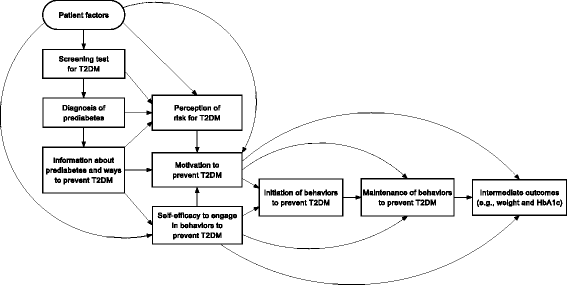ForgIng New paths in DIabetes PrevenTion (FINDIT): Study Protocol for a Randomized Controlled Trial
- PMID: 28388933
- PMCID: PMC5385070
- DOI: 10.1186/s13063-017-1887-6
ForgIng New paths in DIabetes PrevenTion (FINDIT): Study Protocol for a Randomized Controlled Trial
Abstract
Background: Prediabetes is an asymptomatic condition in which patients' blood glucose levels are higher than normal but do not meet diagnostic criteria for type 2 diabetes mellitus (T2DM). A key window of opportunity to increase engagement of patients with prediabetes in strategies to prevent T2DM is when they are screened for T2DM and found to have prediabetes, yet the effects of this screening and brief counseling are unknown.
Methods: In this parallel-design randomized controlled trial we will recruit 315 non-diabetic patients from the Ann Arbor VA Medical Center (AAVA) who have one or major risk factors for T2DM and an upcoming primary care appointment at the AAVA, but have not had a hemoglobin A1c (HbA1c) test to screen for T2DM in the previous 12 months. After informed consent, participants will complete a baseline survey and be randomly assigned to, at the time of their next primary care appointment, one of two arms: (1) to have a hemoglobin A1c (HbA1c) test to screen for T2DM and receive brief, standardized counseling about these results or (2) to review a brochure about clinical preventive services. Participants will complete surveys 2 weeks, 3 months, and 12 months after their primary care appointment, and a weight measurement 12 months after their primary care appointment. The primary outcome is weight change after 12 months. The secondary outcomes are changes in perception of risk for T2DM; knowledge of T2DM prevention; self-efficacy and motivation to prevent T2DM; use of pharmacotherapy for T2DM prevention; physical activity; participation in weight management programs; and mental health. Quantitative analyses will compare outcomes among participants in the HbA1c test arm found to have prediabetes with participants in the brochure arm. Among participants in the HbA1c test arm found to have prediabetes we will conduct semi-structured interviews about their understanding of and reactions to receiving a prediabetes diagnosis.
Discussion: This trial will generate foundational data on the effects of a prediabetes diagnosis and brief counseling on patients' preventive behaviors and mediators of these behaviors that will enable the development of novel strategies to improve patient engagement in T2DM prevention.
Trial registration: ClinicalTrials.gov, NCT02747108 . Registered on 18 April 2016.
Keywords: Brief intervention; Diabetes prevention; Patient education; Patient engagement; Screening.
Figures
References
-
- American Diabetes Association. Standards of Medical Care in Diabetes-2017: Summary of Revisions. Diabetes Care. 2017;40(Suppl 1):S4–5. - PubMed
Publication types
MeSH terms
Substances
Associated data
Grants and funding
LinkOut - more resources
Full Text Sources
Other Literature Sources
Medical
Miscellaneous



